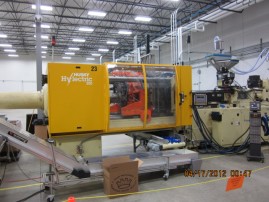Safety first. But there is a way to balance safety and production. Below are some checklists to make sure any plastic injection molding facility is safe for both workers and anyone else on the plant floor. But let’s begin with the basic idea of what’s happening within the equipment you work on or walk by every day. By definition, all plastic processing equipment must melt and move plastics. Melting involves extremely high temperatures, anywhere from 250 F to 800 F, and “moving” means injecting at high pressures. The minimum pressure in injection molding machines is approximately 16,000 psi, and the maximum can be 30K to 50K pounds-per-square-inch.
Let’s think about that for a moment: what would happen if a hose filled with melted plastic at 250 F to 800 F and 16,000 to 50,000 psi broke loose and the contents made contact with you? Answer: At those temperatures and pressures, the hose would explode with so much force that if even if a fraction of it hits your body you could lose an arm or leg or even your life. Unfortunately, this scenario happens more often than you know. Ask some plastic injection molders if they ever saw a resin hopper get blown off the plastic injection molding machine into—or right through—the ceiling. Are there any suspicious dents in the ceiling of your production facility? If so, you might want take a look at the safety features below:
Let’s start with the basics…
- Who is responsible for worker safety? Everyone — from the CEO to the janitor. Admittedly, the CEO carries the brunt of the responsibility for plant safety but even the janitor has a responsibility to make sure he knows where possible danger lurks on the factory floor.
- Does management allow anybody to circumvent the safety equipment (which they all have) on the machines? If so, get ready to hit the bricks; either smart workers and execs will start looking for a new job or inevitably there will be a horrible industrial accident that will force the closure of the plant.
- Is there a designated meeting area outside the plant in case of an evacuation?
- Have you had a practice emergency evacuation drill?
- Is there someone responsible for ensuring everyone has been evacuated?
We’ll talk about other safety checklists in future blog posts. In the meantime, stay safe!
